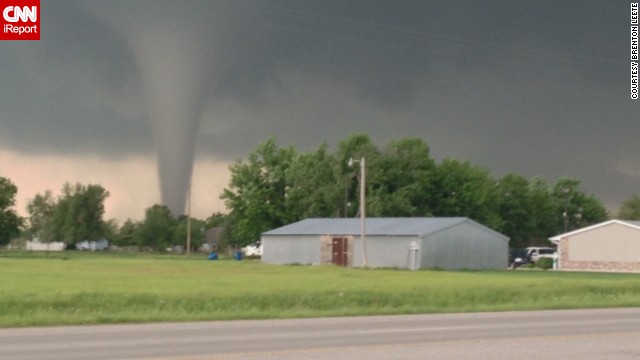
What to do if tornado hits
Emergency officials have
long held that you should just stay put if you're inside anything other
than a mobile home -- and head for the lowest floor and the inner-most
room.
Yet even with improvements to severe weather prediction, no one can say with certainty what a tornado will do.
In Moore, Oklahoma, a woman and her brother took shelter inside their restaurant's walk-in freezer and survived. Another woman and her baby did the same thing at a convenience store -- and died.
Terimy Miller initially
put her three sons into a closet but changed her mind when she turned
on the TV and heard a reporter talking about her neighborhood.
"He said, 'Get out now if
you have no shelter. If you have shelter, get in it. But if you don't,
get out ... it's not safe. Go! It's too huge!'"
So Miller put the boys -- 6, 7 and 11 -- into her car and drove off, her radio on.
"They said, 'It's getting
right close to 19th and 4th," she recalled. "I said, 'Boys, it's right
behind us! You can see it, you can see it!' "
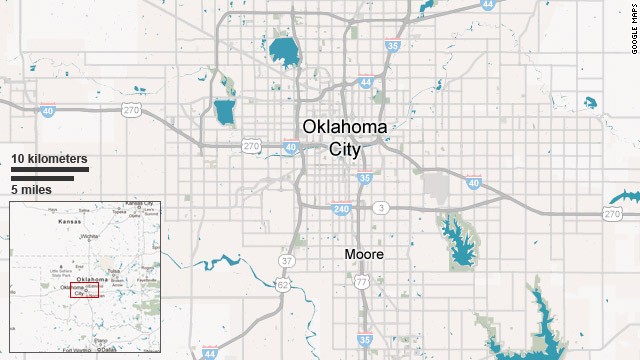 Map: Moore, Oklahoma
Map: Moore, Oklahoma Are tornadoes getting stronger?
Are tornadoes getting stronger?
 Inside a personal tornado shelter
Inside a personal tornado shelter
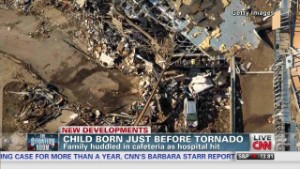 Child born just before tornado
Child born just before tornado
She steered out of its path, escaping unharmed. When she returned, her home -- closet and all -- was destroyed.
Another woman who hid inside her closet survived unharmed after the closet door landed on top of her and protected her.
Outrunning the storm?
While the most common
advice is to shelter in place, some experts say it may sometimes be
smart to do what Miller did -- get into a car and drive -- especially if
you have enough warning.
"You rarely ever have
less than 15 minutes, and usually considerably more," said Ed Bates, an
architect who designs buildings that incorporate storm shelters.
"With the good lead
time, I'd tell people to get in their automobile and go 90 degrees from
that perceived path," said Bates. "It's manageable and easy to do --
even in a city environment."
Given open roads and a
reliable vehicle, the race should not be close. Funnel clouds can travel
as fast as 70 mph, but their average forward speed is only 30 mph, according to FEMA.
The tornado that ripped through Moore on Monday was one of the strongest on record, with winds topping 200 mph. Twenty-four people were killed, 10 of them children. Hundreds more were injured.
The twister damaged or destroyed about 12,000 homes, and state insurance adjusters expect the claims to exceed $2 billion.
Aerial views of what's left of the Oklahoma City suburb testify to the danger courted by those who sheltered in place.
Residents of Moore had 36 minutes from the time the National Weather Service issued its warning until the time the twister entered the city.
But even that lead time would not necessarily have persuaded Ernst Kiesling to try to race out of harm's way.
"It's a tough question,"
said Kiesling, a civil engineering professor at Texas Tech University
who has spent his life studying tornadoes and developing above-ground
storm shelters to protect against them.
"My advice would be to
seek the safest place available. That is: lie in a ditch or ... (get)
behind a heavy object if you had a tractor or even a tree."
He cited the 1979
Wichita Falls, Texas, tornado as a cautionary lesson. That twister
killed 54 people and, Kiesling noted, "many people were killed in
automobiles because they tried to outrun it."
Still, Kiesling allowed, there may be times when fleeing an impending tornado might be a good option.
"If you have good
information on the storm, if you have plenty of warning, if you have an
automobile, it may make sense, but I personally don't feel that's the
advice that we want to give the public."
A better answer, he
said, would be to plan. "I think there is today a storm shelter or
solution for just about every situation, so I would urge people to
consider procuring a storm shelter for their home."
The options for shelters
are many: above-ground, below-ground, mounted in the garage, on the
patio, on a poured slab or even in a space carved out beneath the slab.
Shelters at schools
Ed Bates said he includes provisions for storm shelters in the buildings he designs, but sometimes it's a tough sell.
 Mom speeds away from a tornado
Mom speeds away from a tornado
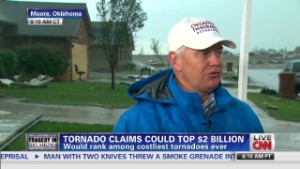 Tornado claims could top $2 billion
Tornado claims could top $2 billion
 Hospital team's heroism during tornado
Hospital team's heroism during tornado
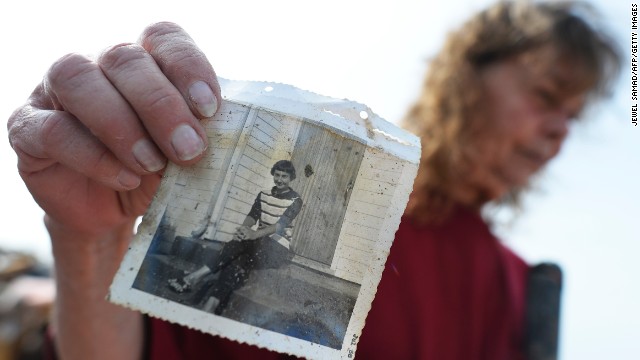 Photos: Deadly tornado hits Oklahoma
Photos: Deadly tornado hits Oklahoma
"It's just disgraceful
for me to see how many schools in Oklahoma continue to get built with
all the priority on athletic facilities," the architect said. "They
don't seize the opportunity to protect from a very imminent danger in
this area."
That was not the case at
Northeastern State University in Tulsa, where his proposals were
welcomed. "We were able to build honest-to-goodness tornado vaults,
concrete vaults, as double-purpose classrooms," he said.
Inside the shelter's
blast-resistant doors is ample space to accommodate the school's
thousands of students and staff members, he said. Its value was driven
home soon after it was completed, when a tornado struck nearby, causing
damage, he said.
"I went out there to the
campus about three days later, and three of the lady professors just
ran up and hugged me and said, 'Mr. Bates, we just want to thank you,'"
he said. "They said, 'What a peace of mind!' "
Teachers at schools
without shelters can find themselves in untenable positions, he said. "A
tornado gets announced, and then the teachers have no choice but to
stay right there until every one of the parents of those children
arrive," he said. "That's not the way it ought to be."
The fact that seven students at Plaza Towers Elementary School
were among the dead has given momentum to advocates for shelters in
schools. Plaza Towers had neither a basement nor a shelter, and neither
did Briarwood Elementary, which was also destroyed, although there were
no fatalities there.
The schools that were
rebuilt in Moore after a tornado in 1999 do have storm shelters, he
said. That one, too, was an EF5, the most powerful category of storm.
Such tornadoes represent a tiny fraction -- about one-tenth of a percent
-- of all tornadoes, according to FEMA.
Most of the schools in
Oklahoma don't have a shelter because of the cost, Moore Mayor Glenn
Lewis told CNN. But he predicted that will change.
 Protecting the school children
Protecting the school children
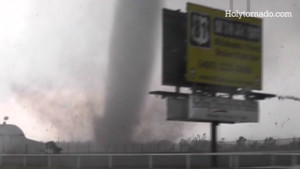 CNN Explains: Tornadoes
CNN Explains: Tornadoes
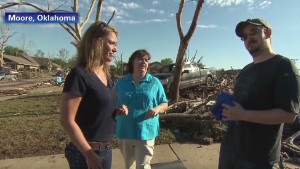 Getting a 'Fraidy Hole'
Getting a 'Fraidy Hole'
 Moore superintendent on storm shelters
Moore superintendent on storm shelters
"There should be a place
that, if this ever happened again during school, that kids can get to a
safe place," said Mikki Dixon Davis, whose 8-year-old son, Kyle, died
at Plaza Towers.
Sen. Tom Coburn,
R-Oklahoma, said it was not clear Kyle would have survived even if he
had had access to a shelter. "Some of the shelters that were utilized
collapsed or were destroyed by the tornado," he said.
"We'll never replace her
child or fill that void in her heart, and we ought to do what we can do
to prevent this kind of result, but there's only so much we can do. We
put 200 shelters in in the last four, five years in Oklahoma in schools,
so it's not like the state hasn't been making an effort."
Leslie Chapman-Henderson rejected "chatter" suggesting that no above-ground shelters could have withstood Monday's winds.
"We don't know that;
that hasn't been determined," said Chapman-Henderson, the president and
CEO of the Federal Alliance for Safe Homes Inc.
"We're concerned it's
going to set the cause of tornado safety back decades if we can't get
fact-based conversations rolling forward," Chapman-Henderson said.
She expressed confidence
that Oklahomans will learn from Monday's events. "I hear a very diverse
voice converging on one message: that this time, we have got to do this
differently."
As the debate continues over whether to invest in storm shelters, here are a few tips that experts say everyone should follow:
-- Don't ignore those warnings
There's a saying in
Oklahoma: If you don't like the weather, just wait five minutes. The
skies can change fast and that makes it hard for weather forecasters to
predict the weather.
But whether you're in
Oklahoma or anywhere else, don't dismiss tornado watches and warnings
just because the forecaster got last week's predictions wrong.
And don't fall victim to thinking a tornado can't happen in your neighborhood.
"Time and fading
memories are the worst enemies," said Chapman-Henderson. "People think
it can't happen twice, but in the case of Moore, Oklahoma, the tragedy
here is this is the third strike -- 1999 to 2003."
Tornadoes can sometimes form so quickly that little, if any, warning is possible, according to FEMA.
-- Grab a helmet
As Monday's tornado
approached, football players at Southmoore High School were getting
ready for practice. The coach rounded up the players and ordered them to
put on their helmets, he told Fox Sports Southwest
The tornado just missed the school.
It's an important
lesson: Protect your head. A 200 mph gust of wind can turn a stick into a
lethal weapon, something even a $10 bicycle helmet might protect
against.
-- Work with what you've got
There's a good chance
that if a tornado approaches, you might not be near a storm shelter or a
basement or your emergency kit, so it's important to use what you have
at the time of the impact to increase your survival chances.
Emergency room doctors at Moore Medical Center pulled mattresses and blankets off hospital gurneys and used them to cover themselves and their patients as the tornado approached.
Those simple items might have saved lives as the tornado wiped out the hospital's second floor.
Workers and customers at a credit union got inside the bank vault, which proved to be the only thing standing after the tornado reduced the rest of the building to rubble.
Teachers and parents lay on top of kids at Briarwood Elementary, using their bodies to shield the children from debris as they rode out the storm.
The tornado wiped out the school and many sustained serious injuries, but everyone survived.
The Red Cross and the National Weather Service have more tips on their websites.
No comments:
Post a Comment